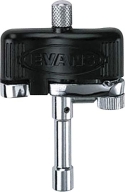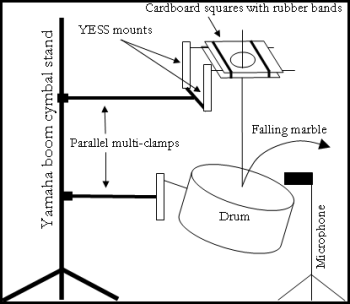The Resonant Time of a Drum Due to Varying Heights of a Dropped Marble
By: Kaetlin Kwiecien & Eric Dauenhauer

Statement of
the Problem Background Review of
Literature Hypothesis Materials Set-up Procedure Data Conclusion Bibliography Additional
Information Back to
Physics
Statement of the problem:
The purpose of this experiment is to find the relationship, if any, of the height of a dropped marble on a drum and the decay time of the sound.Background:
Sound, in terms of physics, is the compression and expansion of air. These changes in pressure are interpreted by our brain to create what we hear. Sound travels in continuous transverse waves, which means that the wave continuously oscillates up and down. The frequency of sound (the rate at which the waves move) is the determining factor in the pitch of the sound, or how high or low the sound is. The amplitude of the waves, or the size, is the measure of volume, or how loud a sound is.
A drum is a cylindrical tube with openings on both ends. A membrane, usually called a drum head, made usually of Mylar is stretched over one or both of the open ends. When the drum head is hit, the head vibrates in and out and physically displaces the air inside the drum. The vibrating drum head creates areas of high and low pressure, and it is these changes in air pressure that creates the sound that we hear. Because the drum heads are usually stretched very tight over the shell of the drum, the drum head will not usually resonate very long, making the sound that it creates relatively short. Having a second head on the drum will allow for more resonation because the sound will be produced by the first head and will then the air pressure changes will cause the second head to resonate as well.
Because the sound of the drum is dependent on a striking object, its volume is also a result of how hard it is hit. If the drum head is hit softly, the head will not be forced to move very much, and the resulting air compression will be smaller (i.e. the sound will be softer). If the head is hit very hard, the increased motion in the head will create a much larger sound due to the larger displacement of air. Also, the resonance of the drum depends on the tightness of the drum head. If a drum head is incredibly loose, it will hardly resonate at all because there will be no force to pull it back to its original position. (The inward and outward motion of the drum head is what causes the air to be compressed and decompressed, so without this motion, there is little sustain to the sound.) If the drum head is incredibly tight, the force to pull it back to its original position will be so strong that the head has trouble vibrating for very long, so the resonance will be short. The ideal tightness for a long resonance is in the middle. The head must have enough force to cause the oscillating motion, but not so much that the motion is limited.
TopReview of Literature:
“The amplitude of sound will diminish over time due to ‘resistance’, and the decay of amplitude over time is called ‘damping’” (Speaks 1996). Speaks defines some general terminology for the decay and makes the important note that the decay of sound is due to external force, which he calls “resistance”. Since the sound created from the drum is energy, the energy must be leaving the drum for the sound to stop. External forces usually cause this, and he classifies these forces as “resistance”.
Jess Josephs (1967) goes into more detail about exactly what causes the sound to decay. He states that there are “four possible mechanisms for energy loss and resulting damping: radiation of sound, mechanical loss in the membrane, viscothermal loss in the confined air, and mechanical loss in the kettle [shell] walls”. This is the physical explanation for how the energy of the sound is leaving the drum. If any of these factors can be reduced or eliminated, it is reasonable to assume that the resonance would increase due to a longer time of energy in the drum.
According to Marshall (2000), the tone of a drum is a result of the oscillating vibrations of the drum head attached to the drum shell. The oscillating drum head creates vibrations within the drum which radiate outward and are perceived as tone by our ears. The properties of the head and shell (i.e. tightness, material, size, depth) all determine the different tones that can be achieved through drums. Also, the resonance is partly dependent on whether the drum has two heads or one. Having a bottom head on the drum will allow the vibrations to reflect back and forth and give a much longer sustain whereas only one head will be shorter. The way to attain maximum resonance is by tuning the two heads identically because they will reflect “in phase” with each other (i.e. the same tone), thereby increasing the duration of the resonance. Also, Marshall says that the density of the drum shell will affect the resonance. While a thinner drum shell will reflect the sound much more and therefore account for a much greater resonance, a thicker or denser shell will absorb more of the sound and achieve a shorter sustain.
Radcliff (1999) focuses specifically on how the relative tunings of the top and bottom drums heads affect sustain. There are three variations of how the two heads can be tuned: 1) They are both tuned to the same pitch, 2) The bottom head is tuned higher than the top head, and 3) The bottom head is tuned lower than the top head. Radcliff agrees with Marshall that having the two heads tuned the same will usually achieve maximum resonance. However, he notes that if the bottom head is tuned slightly higher than the top, it may increase the resonance depending on the depth of the drum. He notes that having the bottom head tuned lower than the top will always result in a shorter sustain.
“The sound decay time depends on a number of factors, such as the type of drum head, the tension, the kettle weight and material, and especially the way in which the drum is supported. Changing the length of the arm on which a drum is supported, for example, can change the decay time of the fundamental from 5.5 s to 0.6 s, and adding mass to the kettle tends to lengthen the decay time” (Fletcher and Rossing, 1991). Fletcher and Rossing did a direct study on the decay time of drums in relation to the thickness and mass of the drum head used. They write, “Decay times measured in the same drum with several different types of drum heads are given in Table 18.8. The 60-dB decay time of the higher (01) mode and that observed in the one-third-octave band at 500 Hz are given.” Their Table 18.8 is reproduced below:
| Head | Mass (g) | Thickness (mm) | T60: (01) (s) | T60: 500 Hz (s) |
| Ambassador | 50 | 0.3 | 0.9 | 2.5 |
| Diplomat | 40 | 0.25 | 0.8 | 2.7 |
| Emperor | 75 | 0.46 | 1.05 | 2.5 |
| Pin strip (2 layers) | 62 | 0.35 | 1 | 1.4 |
| Controlled Sound | 50 | 0.3-0.4 | 1 | 1.1 |
It is clearly shown that the lighter and thinner a drum head is, the longer its sustain will be and that the sustain, or resonance, will be shorter as the head gains mass or thickness.
TopHypothesis:
We believe that graphically (the height of the marble as the independent variable and the sound decay time as the dependent), the results will be in the general shape of a logarithmic curve. While there will be a noticeable correlation at lower heights, when the height of the marble gets larger and larger, the drum itself will limit the decay time of the sound. The material the drum is made of, the acoustics of the room, and the limited resonance of the drum head will make the results approach a certain value. The height will be found by using measuring with a meter stick the height from the drop point to the drum head. The decay time will be measured using a microphone and Logger Pro software. The decay time is defined as the time from the beginning of the noise to the point when the microphone cannot register audible sound.
TopMaterials:

An Evans® torque drum key
- A drum
- Two drum heads of two-ply 7-mil Mylar® (Remo Pinstripe®)
- Three Yamaha YESS® mounts.
- One Yamaha® boom cymbal stand
- Two Yamaha Parallel Multi Clamps
- Two 6.5'' x 5'' squares of cardboard with a 1'' diameter circular hole cut in the center
- Two large rubber bands (e.g. the rubber bands that come on bundles of asparagus)
- A microphone capable of being connected to a computer
- A clamp and stand to attach the microphone within close proximity of the strike point of the drum
- Logger Pro software
- A meter stick to measure the height of the drop
- A piece of paper
- A torque key to tune the drum heads
- A padded surface to silently catch the marble as it bounces off of the drums
Top
Set-up:

This is the actual setup of drum equipment

We used a torque drum tuning key to ensure even tuning across the drum heads and equal tuning for both drum heads. A torque key has a special mechanism that senses the stress of each tension rod, and when it reaches a certain predetermined value, it clicks to alert the user to stop tuning.
The marble dropper was slightly more complex, but still relatively basic. We used a compilation of drum hardware to create a system that would allow an easily adjustable, but also lockable, height, as well as a system to ensure an even and precise marble drop. The drum itself was connected to a YESS drum mount that allowed it to be locked at a steady angle. The marble dropper was two pieces of cardboard (each with a hole in the center), attached to the remaining two YESS drum mounts with the rubber bands. A piece of paper was slid in between the two piece of cardboard and the marble rested on the paper while being confined to the space of the upper hole. When the paper was removed, the marble fell through the bottom hole of cardboard onto a predictable location of the drum. The microphone was then placed very near (within 1.5 inches) the strike point to measure the sound as accurately as possible. A sweatshirt was placed on the floor to silently catch the marble as it bounced off of the drum. Using this marble dropper, we were able to accurately measure the height of the marble before the drop, as well as ensuring that it consistently hit the same spot on the drum.
Finally, we used Logger Pro software and a microphone to record the audio signals of the drum. The Logger Pro software records audio data on an arbitrary 0 to 5 scale, centering around 2.5. Without any external input, the microphone naturally reads approximately 2.8, meaning that the atmospheric noise is approximately 0.3 on their arbitrary scale. We decided that the resonant decay time of the drum would be when the audio signal dropped below 3.0, or 0.2 units above the atmospheric noise.
TopProcedure:
- Set up the drum at a slight angle so the falling marble will bounce off and will be prevented from double-striking.
- Calibrate the Logger Pro software to sample through the microphone as fast as possible for the most accurate readings. Set the data collection time to a sufficiently long time for the drum to stop resonating. Five seconds should be fine.
- Set the initial drop height at 20 cm.
- Place the marble on the piece of paper within the upper hole.
- Begin collecting audio data with Logger Pro.
- Remove the piece of paper from under the marble. This will cause the marble to drop through the second hole and onto the drum head.
- The Logger Pro software will automatically stop collecting data after the set time.
- Analyze the audio signal collected and determine the start time of the drum resonance and the end time (when the audio signal drops below 3.0).
- Record the data and perform at least 5 trials for each individual height.
- Using a meter stick to measure, move the drop mechanism up 10 cm at a time for each set of trials.
- Repeat these steps for as many individual heights as necessary.
Top
Data:

Click here to see the collected data
Click here for the data file (Text, Tab delimited). Right-click to Save As...
Top
Conclusion and Analysis:
Our experiment and data neither proved nor disproved our hypothesis. The experiment was inconclusive. For the first four heights, from .2m to .5m, the decay time increased as the height and velocity increased. The times increased from 2.11 seconds to 2.69 seconds in this range. However, the times for the subsequent heights showed varying results and ultimately showed a decreasing average trend. Although at first sight this seems to show a relationship, sources of error became obvious during the experiment, leading us to believe that more precise data would provide different results.
In order to show an increase in velocity, the height was increased while the other variables were held constant. However, as the height was increased, the consistency and precision of the ball drop declined. The increase in height left more room for the marble to waiver from the middle of the drum and more room for the direction to be affected by any spin created. One solution to this problem may include a computerized device to hit the drum with a consistently measurable known velocity. This would also allow for consistency in the place of contact between the object and the drum.
It is interesting to note that the data found for the lower heights where the striking was more controlled show a consistent increase in decay time. This may be due to the increase in energy provided in the marble, creating larger vibrations and waves. It is unclear whether or not this would have continued into a more logarithmic pattern because of the decline in quality at greater heights.
Other sources of error include the quality of the room where the experiment was conducted. Although the experiment was kept in the same part of the same room, possible changes in the room may have affected the data picked up by the microphone. The marble dropping device also may have provided spin that made an inconsistent contact place between the drum and marble. Human error was also presenting the measuring of height and the reading of sound waves. Most of the sources of error could be minimized in a more closed laboratory setting with newer sound equipment, a computerized striking system, and more accurate measuring.
TopBibliography:
Fletcher, Neville H., Thomas D. Rossing. The Physics of Musical Instruments. New York: Springer-Verlag, 1991.Josephs, Jess J. The Physics of Musical Sound. Princeton, New Jersey: D. Van Nostrand Company, 1967.
Marshall, Paul. Drum Kit / Drumset Mechanics and Construction. Drum Dojo 2000. October 22, 2006. http://www.drumdojo.com/kit/equipment.htm
Radcliff, Mike. Tuning Toms. Drum Dojo 1999. October 24, 2006. http://www.drumdojo.com/tech/tuning.htm
Speaks, Charles E. Introduction to Sound – Acoustics for the Hearing and Speech Sciences. San Diego, California: Singular Publishing Group, 1996.
Top
Additional Information:
Tuning Drums for acoustics: This website has a very detailed description of how drums with two membranes interact and how the waveforms differ based on different tunings of the membranes.Acoustics II: Sound & Vibration: Chladni patterns and vibrational frequencies are exlored in depth in this website.
Tomas Howie Drumming Web - Tuning: This website again looks at the effect of tuning on the vibrations that the drum produces. This website also looks at the effect of the shell on the vibration.
Drum Kit / Drumset Mechanics and Construction: As implied by the title, the construction of a drumset is explored on this website. It also looks at the effects of different shell depths (often found in different types of drums) on the vibrations and decay time that the drum produces.
Acoustics/Placement: This website looks more at how the drum frequencies disperse once they are produced. This website also discussed the optimal places for microphone placement.
Top

